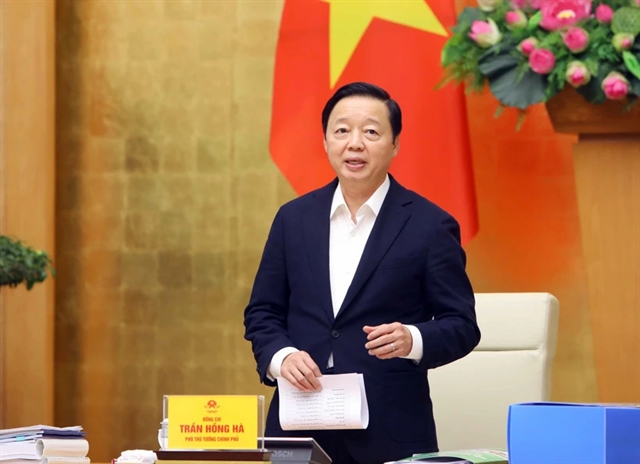
|
| Deputy Prime Minister Trần Hồng Hà was speaking at the conference. — VNA/VNS Photo An Đăng |
HÀ NỘI — Planning in the northern midland and mountainous regions requires a scientific and comprehensive approach to accurately assess their role and position in the country’s overall development.
Deputy Prime Minister Trần Hồng Hà made the statement on Thursday while chairing the session of the Appraisal Council for the planning of the northern midland and mountainous regions for the 2021-2030 period, with a vision towards 2050 in Hà Nội.
The Deputy PM emphasised that regional planning is a crucial management tool for the regional coordination council, serving as a foundation for cohesive and unified implementation, preventing conflicts and overlaps between local planning and others.
He said the planning process needs to be reassessed by examining and evaluating the practicalities, current conditions, and the implementation of previous development strategies, plans and schemes.
In addition, there is a need to identify and fully assess the potential of natural resources and minerals, as well as the cultural and historical values, climate and unique natural landscapes.
Furthermore, planning should evaluate the strategic role and position in ensuring national defence and security, protecting water sources and forests. It should also consider the region as a gateway connecting with dynamic economic zones at both regional and global levels.
The northern midland and mountainous regions hold special strategic importance as the northern gateway of the country, bordering major economic zones. They play a crucial role in supplying water and controlling floods downstream, boasting rich resources, unique landscapes, and cultural diversity among ethnic groups.
However, these regions face limitations in internal and interregional transportation connectivity. Economic growth is uneven, and the quality of the labour force is low, with a declining trend in the proportion of trained workers compared to the national average. Poverty rates also remain high.
Analysing the issues related to infrastructure, deputy PM emphasised the need for thorough research on the feasibility and economic efficiency of various transportation methods including road, waterway, railway and air to connect and form economic corridors, regional and interregional value chains.
In rural development, he called for the organisation of concentrated residential areas with comprehensive investments in infrastructure, facilitating favourable conditions for people’s living and production. These areas should be well cared for regarding healthcare and education to ensure security and safety in border regions.
Regarding mechanisms and policies for remote, highland, and border areas, special attention and priority are essential, along with coordinated solutions and resources to ensure the people’s livelihoods and protect national border security.
Discussing economically advantageous sectors, the deputy PM suggested a shift towards sustainable hydropower exploitation, water resource protection, and integrating solar power with hydropower.
The forestry sector should focus on sustainable and comprehensive forest exploitation and conservation areas linked to natural, community, cultural, historical, and agricultural tourism models, supported by state assistance in workforce training and infrastructure.
Selecting mineral processing industries that are clean and suitable for the transition of industrial zones from the delta regions is also recommended.
The deputy PM also proposed that the planning consultancy unit research and consider feedback on promoting long-term education and workforce training by population distribution principles. In the short term, efforts should be made to enhance education accessibility and career orientation.
Scientific criteria for natural geography, politics, economics, culture, and society should be established when determining sub-regions and economic corridors. The strategy includes opening up additional pathways to the sea.
“The planning of the northern midland and mountainous regions must reveal hidden values, promote the potential of green resources, unique cultural and historical values, and highlight features in each sub-region to attract long-term investment from businesses,” he said.
The consulting unit proposes dividing the area into four sub-regions.
The western sub-region will focus on sustainable agriculture, ecotourism, and clean energy development.
The northwestern sub-region is envisioned as a large-scale tourism area and an economic and cultural hub connecting with provinces in the southwestern part of China.
The northeastern sub-region will be a centre for industry, education, healthcare, and tourism resources.
The eastern sub-region will feature an industrial hub connected with economic and cultural exchanges with provinces in southern China.
The economic corridors of the northern midland and mountainous regions include Hà Nội-Hoà Bình, Lào Cai-Hà Nội-Hải Phòng, Hà Nội-Phú Thọ-Tuyên Quang-Hà Giang, Hà Nội-Thái Nguyên-Bắc Kạn-Cao Bằng, Hà Nội-Bắc Giang-Lạng Sơn. — VNS
- Reduce Hair Loss with PURA D’OR Gold Label Shampoo
- Castor Oil Has Made a “Huge” Difference With Hair and Brow Growth
- Excessive hair loss in men: Signs of illness that cannot be subjective
- Dịch Vụ SEO Website ở Los Angeles, CA: đưa trang web doanh nghiệp bạn lên top Google
- Nails Salon Sierra Madre
 VnExpress News The News Gateway of Vietnam
VnExpress News The News Gateway of Vietnam





